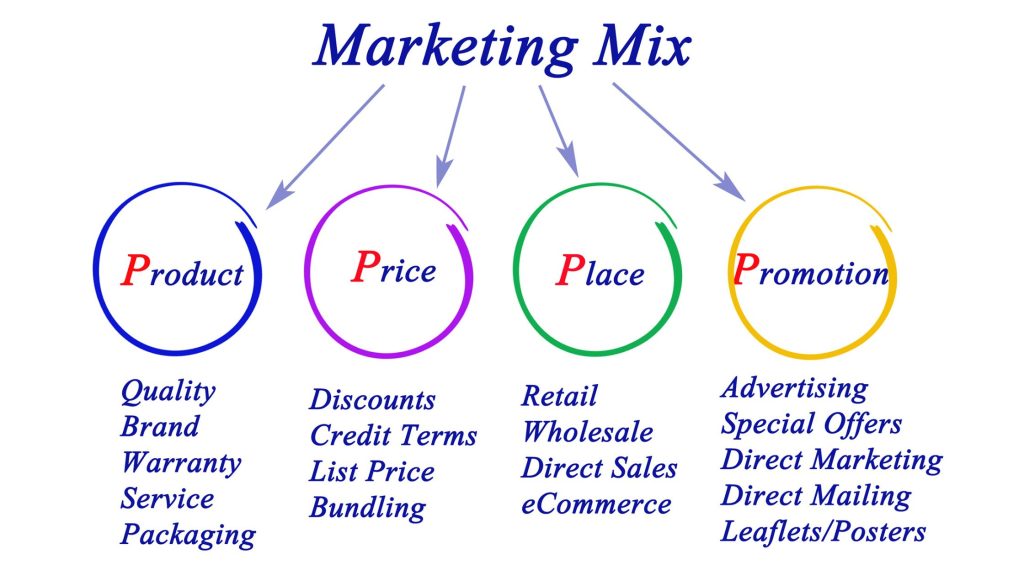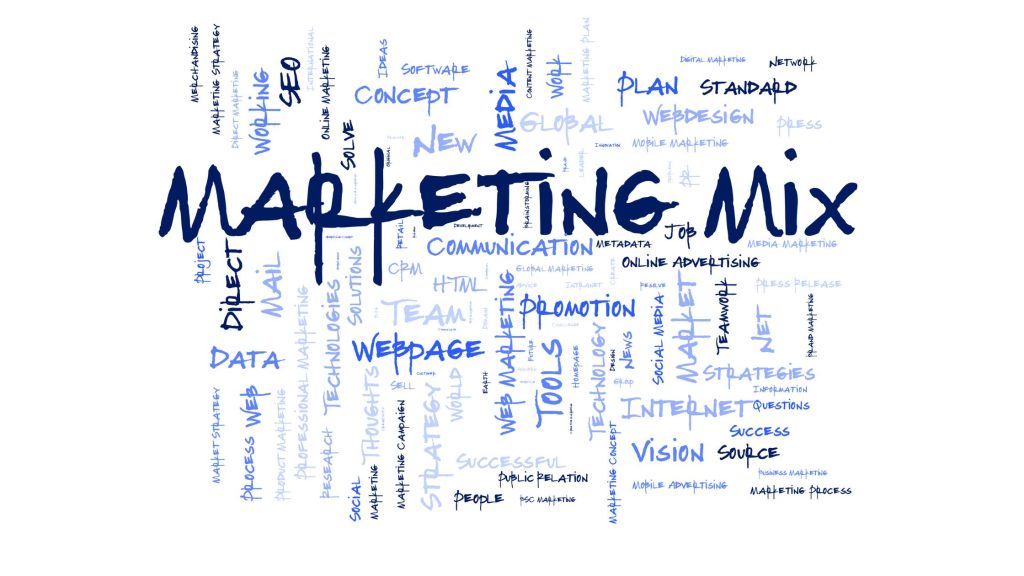In the world of marketing, both the 4 Ps and the 7 Ps are essential frameworks used by businesses to design and implement effective marketing strategies.
The 4 Ps, also known as the marketing mix, were first introduced by E. Jerome McCarthy in the 1960s as a framework to help businesses create a comprehensive marketing plan. While the 4 Ps model has been a classic staple in marketing for decades, the 7 Ps model builds upon the foundational elements and adds three additional Ps to address specific aspects of service-based industries.
In this guide, we will delve into each of the 4 & 7 Ps of marketing and understand their significance in developing a successful marketing strategy.
The 4 Ps of Marketing

1. Product
The first P in the marketing mix is “Product.” It refers to the tangible or intangible goods and services that a company offers to its customers. The product aspect of marketing involves understanding the features, benefits, and unique selling points of the product, as well as its overall quality and packaging.
Key considerations under the Product category include:
- Product Features: What are the distinctive features and functionalities of the product? How does it stand out from competitors?
- Product Benefits: How does the product fulfill the needs and desires of the target market? What problems does it solve for customers?
- Product Quality: Is the product of high quality and meets customer expectations? How does it compare to similar products in the market?
- Branding: How is the product branded? Is the brand image consistent with the company’s values and target audience?
- Packaging: How is the product packaged? Does the packaging appeal to the target market and enhance the overall customer experience?
- Product Life Cycle: Where does the product stand in its life cycle (introduction, growth, maturity, or decline), and how does it affect marketing strategies?
Example:
Imagine a company that manufactures smartphones. For their latest product, they focus on innovative features, such as a high-quality camera with advanced image stabilization, long-lasting battery life, and a sleek design. The product is branded as a premium device, and the packaging is both aesthetically appealing and eco-friendly. The marketing strategy emphasizes the product’s unique features and its ability to cater to photography enthusiasts and tech-savvy consumers.
Also Read: Ansoff Matrix Examples, Basis for the Growth Strategies of Top Companies
2. Price
The second P in the marketing mix is “Price.” Pricing is a critical aspect of marketing that directly impacts a company’s revenue, profitability, and market positioning. The pricing strategy should align with the product’s value proposition, target market, and competitive landscape.
Key considerations under the Price category include:
- Pricing Strategy: Will the product be positioned as a premium offering, mid-range, or budget-friendly? What pricing approach (cost-based, value-based, competition-based) will be used?
- Pricing Objectives: What are the company’s pricing objectives? Is the goal to maximize profits, gain market share, or penetrate a new market?
- Perceived Value: How do customers perceive the product’s value in relation to its price? Is the price considered reasonable for the benefits offered?
- Discounts and Promotions: Will the company offer discounts, seasonal promotions, or special offers to attract customers?
- Price Elasticity: How sensitive are customers to changes in price? Will price changes significantly impact demand?
Example:
A newly launched premium coffee brand decides to position its products as high-end, targeting coffee enthusiasts who appreciate unique and exotic flavors. The pricing strategy focuses on value-based pricing, emphasizing the exceptional quality and rare sourcing of coffee beans. The company offers limited-time promotions to attract initial customers, but the long-term pricing remains higher due to the perceived value associated with the brand.
3. Place (Distribution)
The third P in the marketing mix is “Place.” This refers to the distribution channels and methods a company uses to make its products or services available to customers. That is because the right distribution strategy ensures that the product reaches the target market efficiently and conveniently.
Key considerations under the Place category include:
- Distribution Channels: Will the product be sold through retailers, wholesalers, direct sales, e-commerce platforms, or a combination of these channels?
- Geographic Coverage: In which regions or locations will the product be available? Will it be limited to specific areas or sold globally?
- Inventory Management: How will the company manage its inventory and ensure products are readily available for customers?
- Logistics and Transportation: What methods of transportation and logistics will be used to deliver products to customers? How will the company handle shipping and handling?
- Physical Locations: If the company has physical stores or outlets, where will they be located? What is the store’s layout and ambiance?
- Online Presence: How will the company leverage online platforms and digital marketing to reach and engage customers?
Example:
A fashion brand decides to sell its products through a combination of physical retail stores and an e-commerce website. The company opens flagship stores in prime shopping locations in major cities to create a luxurious shopping experience for customers. Additionally, the brand invests in an e-commerce website that showcases its entire product range and allows customers from all regions to make online purchases with doorstep delivery.
4. Promotion
The fourth P in the marketing mix is “Promotion,” which encompasses all activities aimed at communicating and promoting the product to the target market. Promotion plays a crucial role in building brand awareness, creating interest, and driving sales.
Key considerations under the Promotion category include:
- Advertising: How will the company advertise its products? What advertising channels (TV, radio, print, digital, social media) will be used?
- Public Relations (PR): How will the company manage its public image and create positive publicity? Will it engage in media relations, sponsorships, or events?
- Sales Promotion: What sales promotion tactics (coupons, discounts, contests) will the company use to incentivize purchases?
- Personal Selling: Will the company use a sales team to engage with customers and sell the product directly?
- Digital Marketing: How will the business utilize its digital marketing channels (social media, email marketing, content marketing) to reach the target audience?
- Integrated Marketing Communications (IMC): How will the marketing team coordinate different marketing channels to deliver a consistent message?
Example:
A software company launches a new productivity tool targeting professionals and businesses. The promotion strategy includes digital marketing campaigns on social media platforms, search engines, and industry-specific websites. The company also invests in content marketing, creating blog posts and video tutorials to demonstrate the tool’s capabilities. Additionally, the sales team conducts personalized product demos for potential clients, showcasing the software’s benefits for their specific needs.
The 7 Ps of Marketing
The 7 Ps of Marketing is an extended version of the original 4 Ps model. It was introduced later to address the complexities of specific industries and services. The additional three Ps focus on elements that are particularly relevant to service-based businesses:
5. People
In service-oriented industries, the people aspect refers to the personnel who directly interact with customers. It includes the training, skills, and attitude of employees, as they play a significant role in delivering the service experience.
6. Process
The process element involves the systems and procedures that govern service delivery. It includes the steps taken to deliver the service, customer interaction processes, and service efficiency.
7. Physical Evidence
This element relates to the tangible elements that represent the service. It includes the physical environment where the service is delivered, as well as any tangible elements that support the service experience.
Key Differences between the 4 Ps and 7 Ps of Marketing

The primary difference between the two models lies in the scope and focus:
- Applicability: The 4 Ps of Marketing are widely applicable to both product-based and service-based businesses. It provides a broad and universal framework for developing marketing strategies. On the other hand, the 7 Ps are more relevant and comprehensive for service-based industries, where customer experience and service delivery play a crucial role.
- Inclusion of Service Elements: The 7 Ps address the unique challenges of service marketing by including People, Processes, and Physical Evidence. These elements are not as relevant in product marketing, where the focus is primarily on the tangible attributes of the product.
- Service Differentiation: The 7 Ps emphasize the importance of customer interaction and the role of employees in delivering quality services. It recognizes that service businesses differentiate themselves through the service experience. This experience is heavily influenced by the people and processes involved.
- Customer Experience: While both models consider the customer perspective, the 7 Ps give more prominence to the customer experience as a differentiating factor for service-based businesses.
4 vs 7 Ps of Marketing: Which Model Should You Use?
The choice between the 4 Ps and 7 Ps of Marketing depends on the nature of your business and the industry you operate in:
- Product-Based Businesses: For businesses primarily focused on physical products, the 4 Ps model provides a solid foundation for developing marketing strategies. It covers essential elements like product design, pricing, distribution, and promotion.
- Service-Based Businesses: For service-based businesses, especially in industries like hospitality, healthcare, or professional services, the 7 Ps offer a more comprehensive approach. They ensure a holistic consideration of factors that directly impact the customer experience.
- Hybrid Businesses: Some businesses offer a combination of products and services. In such cases, a hybrid approach can be beneficial, incorporating relevant elements from both models.
To make it more simple for you:
- Use the 4 Ps of Marketing when:
- You are primarily marketing physical products.
- Your business revolves around product-centric strategies.
- You want a concise and straightforward model for marketing decision-making.
- Use the 7 Ps of Marketing when:
- You are in a service-based industry or offering intangible services.
- Your marketing efforts heavily revolve around customer experiences and interactions.
- You need a more comprehensive framework that covers service-specific aspects.
Ultimately, both models emphasize the importance of customer-centricity, understanding target markets, and delivering value to customers. The choice between the two depends on the industry, business focus, and the specific marketing challenges you are aiming to address.
Conclusion
The 4 Ps and 7 Ps of marketing are two powerful frameworks that can help businesses develop effective marketing strategies. We learned that the 4 Ps are product, price, place, and promotion, while the 7 Ps add people, process, and physical evidence.
As for applicability, the 4 Ps are a good starting point for businesses that sell products. They can help businesses think about the features and benefits of their products, how to price them competitively, where to distribute them, and how to promote them to their target audience.
The 7 Ps are a more comprehensive framework that is useful for businesses that sell products or services. They add people, processes, and physical evidence to the mix. People refer to the people who work in the business and interact with customers. Process refers to the systems and procedures that the business uses to deliver its products or services. Physical evidence refers to the tangible elements of the business, such as its branding, website, and physical locations.
Whichever framework you choose, it’s important to remember that effective marketing is about more than just following a formula. It’s about understanding your target audience, conducting market research, and creating a customer-centric approach. By leveraging the appropriate marketing mix, you can create compelling and tailored strategies that meet your business objectives and drive long-term success in the market.


